人教版高中英语选修八Unit3课件
- 格式:dps
- 大小:5.36 MB
- 文档页数:40
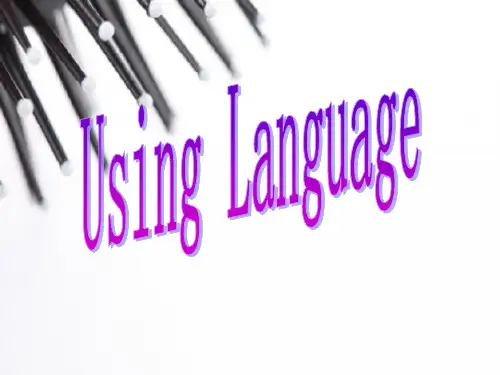
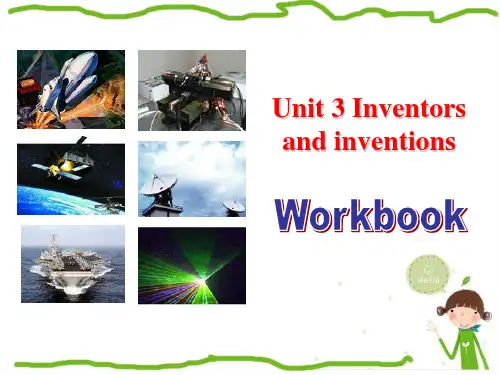
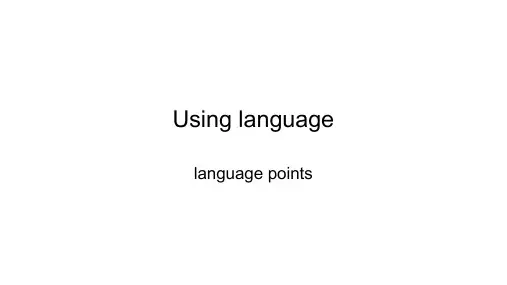
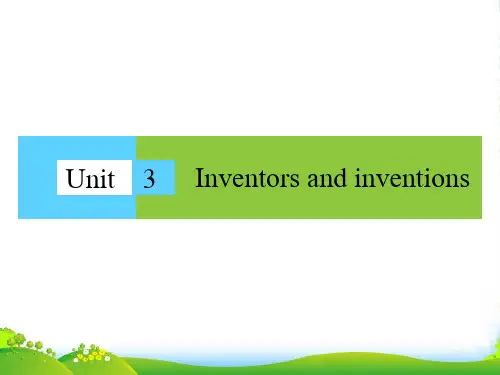
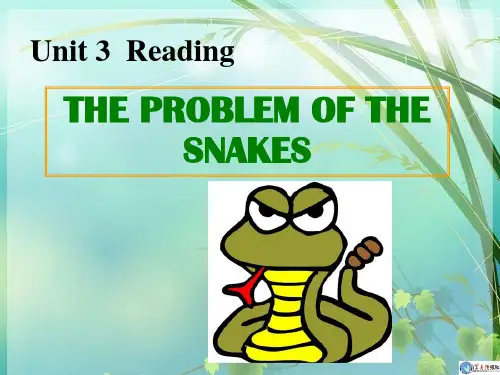
Unit 3 Inventors and inventions Warming up & ListeningUnit 3 Inventors and inventions Warming up & ListeningWarming upWhen we speak of inventions, we can ’t help thinking of the four great inventions in ancient China. Can you name them?paper-making printingcompass gunpowderHow many famous inventors do you know?What did they invent?Zhang Heng (78—139)SeismographThomas EdisonAmerica(1847——1931)Electric bulbTelephoneAlexander Graham BellEngland(1847--1922)Wilbur and Orville Wright invented the airplane , which they patented as a “flying machine ”.What is he famous for?Issac Newton艾萨克·牛顿discoveredgravityWhat is she famous for?Madame Curie玛丽亚·斯克沃多夫斯卡-居里discoveredradiumWhat is he famous for?Ben FranklindiscoveredLightning is electricityA discovery is merely making known something that already _____ in nature.An invention is something that is ______ by a human being.created exists= =Please look at the following pictures and decide which are discoveries and which are inventionsAn amphibious carIt’s ________an invention.Columbia the New Continent It ’s ________a discovery.1493,3,15Stephenson’s “Rocket”an invention.DNA a discovery.23867541•It is a tool of communication;•It is convenient to take along with you;•You can hear a person’s voice when using it.•You can call up sb now and then;mobile phone1It ’s always equipped in high buildings;lift /elevatorPeople can go up and down in itinstead of climbing steps .It looks like a small room;vvv 2•It is a kind of make-up invented by French.•It smells good.•Women especially like to use it.perfume3•It is one of the four great inventions in ancient china.•It is black.•People can use it to make bombs.gunpowder4•This invention is made of metal.•This invention looks likea bird.•It makes it possible for people to flyto different places in the world.•It is powered by an engine and isflown by a pilot.Airplane5•It allows you toget a likeness of an object.•When you press the button, it works . When a flash happens, it will copy a scene onto a film. •When the film is developed, the scene you copied appears on a paper-like thing.Camera•This inventioncan help people do some daily work. •It is helpful for housewives. •The machine can move something that you put into it. •It needs soap and water to wash something in it. Washingmachine•It is a means of transportation.•It has four wheels.•People can drive it on land. •People can also drive it on water.amphibious car8DiscussionAmong the inventions above, which invention do you think is the most important one? Why? How did it change people’s daily lives?The purpose of inventions isconvenient to make our life morecomfortableListening :Please think about the questions before listening1.What functions are already included on a mobile phone?2.What else do you expect a mobile phone to do for you?Ⅰ. Listen to the tape and tick the descriptions you have heard. a mobile that “thinks ” a mobile that does videotaping a mobile that spends your money a mobile that is a computer a mobile that can teach you English a mobile that wakes you up a mobile that plans your holiday a mobile that orders your food √√√√√II. Listen to the tape again and choose the best answers.1.What is Ruth Bacon going to buy?A.A washing machineB. A mobile phoneC. A computer2. The 3G phones can do the following things except_A.Order foodB. Plan a holidayC. Book air tickets and hotels3. What kind of mobile phone does Ruth Bacon want?A. One that can order goodsB. One that can “think”C. One that can turn itself on when it receives important callsElectric shoesThe heel of these shoes is a machine that makes electricity with every step you take. You will never need to buy batteries again.Inflatable bicycle You will never have to worry about having your bike stolen again. If you use our inflatable bike, you can simply let the air out and put your bike in a bag.Edible chopsticksNever throw away or wash chopsticks again. These chopsticks are both delicious and environmentally friendly. Save trees and have a snack at the same time –they come in five different flavours.How to be agood inventor?CreativeCuriousHard-workingImaginativePatientAdventurous…◆Write a passage about a modern invention .◆Preview the reading passage.。